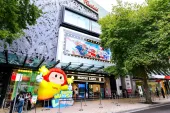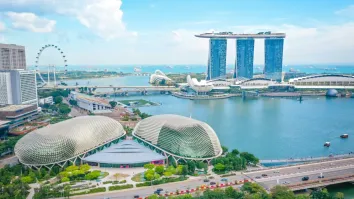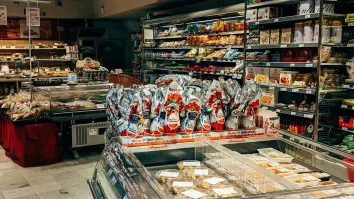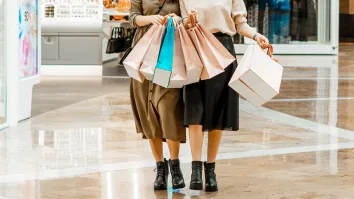
Maintaining O+O presence key for Hong Kong retailers’ operations
Offline-plus-online will help attract more consumers whilst travel is still restricted.
With a market dependent on tourists, but borders remaining closed, Hong Kong retailers have to maintain their presence both online and offline to capture more customers.
As there is a low number of tourists coming in, Hong Kong businesses have to appeal to the locals to continue their purchases, whilst at the same time ensuring a strong online presence to attract consumers overseas.
“It doesn't matter where the tourists come to Hong Kong or not, they can still buy their products on the e-commerce basis. So Hong Kong retailers need to make their business model way a bit more of what we call O+O situation, offline-plus-online, not online or offline,” Michael Cheng, Asia Pacific, Mainland China, and Hong Kong Consumer Markets Leader of PwC, told Retail Asia.
“It doesn't matter whether [the customers] are in Hong Kong or elsewhere as long as they are able to get access or able to feel or use or buy their products, they should at least start to engage with this customer no matter where they are in the future,” he added.
Cheng cited the strategy employed by Watson which uses technology to try on their cosmetic products virtually, amongst other operation changes.
Total retail sales in Hong Kong in July was estimated at HK$27.2b, a 2.9% increase from the same period last year, according to the Census and Statistics Department (C&SD). Online sales accounted for 7.5% of the total retail sales value during the month, estimated at HK$2.1b, which is a 29% year-on-year increase.
For the first seven months of 2021, the estimated online retail sales value rose by 50.6% compared to the same period last year, according to the C&SD.
Cheng also noted that the Hong Kong government issued a HK$5,000 electronic consumption voucher to the people who registered, which can be used for e-commerce and transportation spending.
E-commerce sales proportion is seen to continue to increase as Hong Kong is slow in doing so compared to other countries with a bigger proportion of e-commerce sales and on the back of government support, Cheng said. He added that the percentage of online retail sales may reach 10% in one or two years.
Total visitor arrivals in Hong Kong from Mainland China reached 6,304 in July, up 9.9% from 5,735 million in July 2020. Visitors from the Mainland during the first seven months of 2021 was at 30,567 which is a 98.9% decrease from 2.7 million in the same period last year, according to data from the Hong Kong Tourism Board. Overall visitor arrivals from January to July 2021 was at 42,415, 98.8% lower than the 3.5 million visitors during the same period in 2020.
Euromonitor International Senior Research Analyst Emily Leung said the Hong Kong retail market has declined by almost a quarter in 2020 compared to 2018, affected by both the political events and the pandemic.
She added that the key for retailers is having a good omnichannel strategy, and maintaining both online and offline stores. Leung added that a lot of retailers in Hong Kong opened their first online stores last year, citing drugstore brand, Mannings, as an example.
“E-commerce is going to be continually on the rise for the next couple of years to come. But in terms of the increase, it's going to be less than the previous years before,” Leung said.
For online retailers to maintain their business, they should ensure having good logistics and opening up more digital payment capabilities, she said.
Vijay Bhupathiraju, a senior analyst at GlobalData, said that even if there is a shift to digital shopping especially with the younger population and is seen to continue to grow until 2025, store-based retailers will still continue to dominate the retail market in Hong Kong.
But despite this, Hong Kong retailers should continue their investment in various digital channels and omnichannel strategies to stay relevant.
“They should also focus more on social media engagements to stay connected with shoppers. Exploring ways to double use their existing store space for online fulfilments helps them maximize their utility,” Bhupathiraju said.
Physical stores
Brick-and-mortar stores, however, still remain relevant, Cheng said. He noted that people in Hong Kong are now buying more in physical stores than online, following the lockdown in early 2021.
He added that Chinese shoppers are also looking for physical stores and not just e-commerce sales.
“It’s no longer they will only look for e-commerce they will also look for physical to make sure they are able to feel the goods, to test the goods, and also to understand a bit more of the goods in store,” he said.
PwC in September estimated retail sales in Hong Kong to increase by 10% to HK$360b in 2021, cutting its earlier forecast in February of 15% to HK$376b.
Cheng said in a statement that the estimate was readjusted because the reopening of the border between Hong Kong and Mainland China is unlikely to happen in the fourth quarter, resulting in businesses relying heavily on local consumers.
Limited travel through “Come2hk” quarantine free-scheme, which allows up to 2,000 non-Hong Kong residents per day from Mainland China and Macau to visit Hong Kong starting 15 September and the “Return2hk” Scheme, will still contribute to retail sales in the region.
Leung also noted that offline stores are expected to make a strong comeback because of lower rents and local brands planning to expand their businesses.
However, she pointed out that businesses should rethink the role of their stores, noting that before, customers go to the stores to complete their transactions but now, they are coming for experience as customers are buying online.
Consumers would want to do their research on the store about the products but they do not necessarily buy them there as sometimes prices are cheaper online or they want the products to be delivered, Leung said.
“From now onwards, and also for now that Hong Kong has lost out on so many mainland Chinese tourists, I think it's very important as a retailer to think about how you're going to capture this Mainland Chinese tourists business that you've lost. Is it about developing overseas commerce capabilities,” she said, adding that they could open stores in e-commerce sites.
“It's very important to have the above elements of the online and offline strategy,” she said. “Offline has experienced such a decline, it might have undergone a strong rebound for the first couple of years. But I think, all in all, digital online sources have a lot more market potential at the moment.”
Consumer trends, challenged sectors
Luxury items are still struggling due to low tourist arrivals from Mainland China. This year, Bhupathiraju said they expect sectors such as clothing and footwear, and health and beauty to “gain share in overall retail sales” compared to 2020 as “normalcy” returns.
But sectors such as home and electrical will struggle in their share in overall retail sales through 2021 and is set to decline compared to last year being non-essential items, he added.
Full recovery for Hong Kong’s household spending is expected to take place after 2025 due to private consumption growth seen to be weak over the medium-term, according to Ng Jun Ying, Consumer and Retail analyst at Fitch Solutions.
“In 2021 and at least for the first half of 2022, retail spending will likely remain weighed down by lacklustre tourism prospects, labour market conditions and weak property market,” he said.
Ng added that they are seeing an acceleration in the growing preowned resale luxury fashion with Gen-Zs and millennials driving its sales, whilst on-trade alcohol sales will remain “depressed” due to the “healthification” trend.
Meanwhile, PwC’s Cheng noted that the luxury sector saw a 32.7% year-on-year increase in sales value of luxury items, such as jewellery, watches and clocks, and other valuable gifts, to HK$21.9b from January to July this year, citing data from C&SD.
He noted that last year people were wary of their jobs and businesses and would prefer not to spend. But because the situation is getting better with the unemployment rate about less than 5% and restrictions were eased, they chose to spend more.
“The revenge shopping behaviour has happened in Hong Kong,” he said.
Despite this, he noted that sales in the luxury sector are still far from pre-pandemic levels, with luxury retail sales forecasted to reach HK$42b this year, from HK$30.5b in 2020.
Leung said Hong Kong consumers are also supporting local brands and showing support to their community.
At the same time, brands are switching focus to the local segment due to the lack of tourist spending. They are adopting different promotional strategies such as being active on social media and choosing local celebrities as endorsers who can target the younger population.



















 Advertise
Advertise





